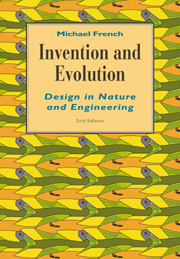Book contents
- Frontmatter
- Contents
- Preface to the second edition
- Preface to the first edition
- Acknowledgements
- 1 The designed world
- 2 Energy
- 3 Materials
- 4 Mechanism
- 5 Structures
- 6 Systems
- 7 The practice, principles and philosophy of design
- 8 Economy, form and beauty
- 9 Production, reproduction, evolution and design
- 10 Designing and inventing
- 11 Some case studies
- Questions
- Answers
- Suggestions for further reading
- Index
5 - Structures
Published online by Cambridge University Press: 06 January 2010
- Frontmatter
- Contents
- Preface to the second edition
- Preface to the first edition
- Acknowledgements
- 1 The designed world
- 2 Energy
- 3 Materials
- 4 Mechanism
- 5 Structures
- 6 Systems
- 7 The practice, principles and philosophy of design
- 8 Economy, form and beauty
- 9 Production, reproduction, evolution and design
- 10 Designing and inventing
- 11 Some case studies
- Questions
- Answers
- Suggestions for further reading
- Index
Summary
The term structure is used very widely for any complex whole showing functional relationships between its parts, as, the management structure of a company, the structure of a language, etc. In this chapter its use will be confined to load-bearing structures, material (but not necessarily solid) bodies that sustain or resist forces. Most of the designed world consists of structures of one kind or another; aqueducts and arteries, boilers, bones and bridges, cathedrals and car bodies, teeth, termitaries, trees, tyres and tennis rackets are all structures whose design is chiefly dictated by the loads they must sustain.
Very often there is a conflict between the structural and other functions – the wing of a bird or an aircraft is best made thick for strength and thin for performance, a brick will be able to carry more load if it is dense but it will be a better thermal insulator if it is porous, and so on. Nearly always it is desirable to use as little material as possible both for reasons of economy, which apply no less in nature than in human affairs, and also usually for functional reasons. For example, more stone than necessary in the top of a cathedral would not only have been more laborious to raise, but might have led to collapse lower down, and bones, car-bodies, tyres and tennis rackets are all structures in which extra mass requires extra force to accelerate it, and is therefore undesirable.
- Type
- Chapter
- Information
- Invention and EvolutionDesign in Nature and Engineering, pp. 108 - 146Publisher: Cambridge University PressPrint publication year: 1994



